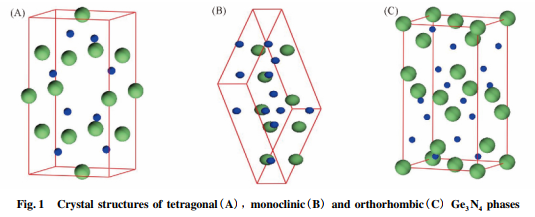Professional industry ceramic supplier, silicon nitride, silicon carbide, aluminum nitride and any other kinds of ceramics.
Overview of germanium nitride Ge3N4 powder
Germanium nitride is an inorganic compound with a molecular weight of 273.95 g/mol. In its pure state, germanium nitrogen (IV) is a colorless inert solid, which can crystallize into a variety of crystal forms, the most stable of which is the triangular β form (space group P31C). The tetrahedron and the nitrogen atom are triangular. The γ-type formed under high pressure has a spinel structure.
Due to their excellent mechanical properties and thermodynamic properties, the nitrides of IIIA and IVA elements can usually be used as high-temperature structural materials, catalysts, light-emitting diodes and refractory ceramics. The current experimental and theoretical studies are mainly focused on BN and Si3N4 materials, and there are relatively few studies on germanium nitride (Ge3N4). In fact, because Ge atoms have higher carrier mobility than Si atoms, semiconductor field effect transistors made of germanium have more excellent performance. The radius of germanium atoms is relatively large, so the critical pressure for the phase transition of Ge3N4 is lower than that of Si3N4. Germanium nitride also has the advantages of corrosion resistance, high hardness, adjustable band gap, etc., so it has great application prospects.

Study on Polymorphs of Germanium Nitride Ge3N4
Using quantum chemistry ab initio calculation method, the microstructure, density of state and phonon spectrum of Ge3N4 tetragonal, monoclinic and orthogonal structure isomorphs were studied. The formation enthalpy is negative, the elastic constant satisfies the Born stability criterion, and the phonon spectrum has no imaginary frequency. The results confirm that the three phases can maintain structural stability within the range of 020 GPa. The temperature change affects the unit cell volume, which changes the body modulus. The three kinds of Ge3N4 are all semiconductors, and there is an obvious s-p hybridization phenomenon between Ge atoms and N atoms. When the pressure increases, delocalized electrons are induced, which reduces the band gap of the system. This study also uses quasi-harmonic approximation to study the thermodynamic properties of Ge3N4. The results show that temperature and pressure have significant effects on the thermal expansion coefficient, entropy, heat capacity, Debye temperature and Green Eisen parameters. The thermal expansion coefficients of m-Ge3N4 and t-Ge3N4 are 3 times and 2 times that of o-Ge3N4, respectively. The lattice resonance frequency of t-Ge3N4 and o-Ge3N4 is basically not affected by temperature.
Using the plane wave + pseudopotential method under the framework of the first principles, three new structures of Ge3N4 are calculated. The calculation results show that germanium nitride with tetragonal, monoclinic and orthogonal structures satisfies the mechanical and thermodynamic stability conditions and can exist stably. The shear resistance and hardness of o-Ge3N4 are the highest among the three. In this paper, the phonon spectra of the three phases are obtained, namely, the dielectric function, the energy loss spectrum and the light absorption spectrum; the study found that the absorption of the three phases in the visible light region is very weak, mainly showing the characteristics of ultraviolet absorption. The peak of the imaginary part of the dielectric function is formed by the transition of electrons from N-2p orbitals to Ge-4s and 4p orbitals. The phonon spectrum shows the characteristics of hybridization of N atoms and Ge atoms.
Application of Ge3N4 Germanium Nitride Powder
The IIIA and IVA elements of nitride have good mechanical and thermodynamic properties, and are usually used as high-temperature structural materials, catalysts, LEDs and refractory ceramics. In fact, since Ge atoms have higher carrier mobility than Si atoms, semiconductor field effect transistors made of germanium have better performance. Due to the large radius of germanium atoms, the critical pressure of phase transition of Ge3N4 is lower than that of Si3N4. Germanium nitride also has the advantages of corrosion resistance, high hardness, adjustable band gap, etc., so it has broad application prospects.
Germanium nitride is also used as an anti-reflection layer and chemical vapor deposition (CVD) in integrated circuit devices.
Germanium Nitride Ge3N4 Powder Price
The price of germanium nitride Ge3N4 powder will vary randomly with the production cost, transportation cost, international situation, exchange rate and the supply and demand of germanium nitride Ge3N4 powder market. Tanki New Materials Co., Ltd. aims to help various industries and chemical wholesalers find high-quality, low-cost nanomaterials and chemicals by providing a full set of customized services. If you are looking for germanium nitride Ge3N4 powder, please feel free to send an inquiry to get the latest price of germanium nitride Ge3N4 powder.
Germanium Nitride Ge3N4 Powder Supplier
As a global supplier of germanium nitride Ge3N4 powder, Tanki New Materials Co., Ltd. has extensive experience in the performance, application and cost-effective manufacturing of advanced engineering materials. The company has successfully developed a series of powder materials (molybdenum disilicide, lanthanum nitride (LaN powder, Ge3N4, iron boride), high-purity targets, functional ceramics and structural devices, and provides OEM services.
| Germanium Nitride Powder Properties | |
| Other Names | Germanium(III) nitride; Tris(nitrilogermyl)amine; 1-Nitrilo-N, |
| N-bis(nitrilogermyl)germanamine; Germanium Tetranitride; | |
| Trigermanium tetranitride | |
| CAS No. | 12065-36-0 |
| Compound Formula | Ge3N4 |
| Molecular Weight | 273.95 |
| Appearance | Crystalline solid |
| Melting Point | N/A |
| Solubility in water | N/A |
| Density | N/A |
| Purity | 100.00% |
| Particle Size | -100 mesh |
| Boling point | N/A |
| Specific Heat | N/A |
| Thermal Conductivity | N/A |
| Thermal Expansion | N/A |
| Young's Modulus | N/A |
| Exact Mass | 271.779797 g/mol |
| Monoisotopic Mass | 277.775829 g/mol |
